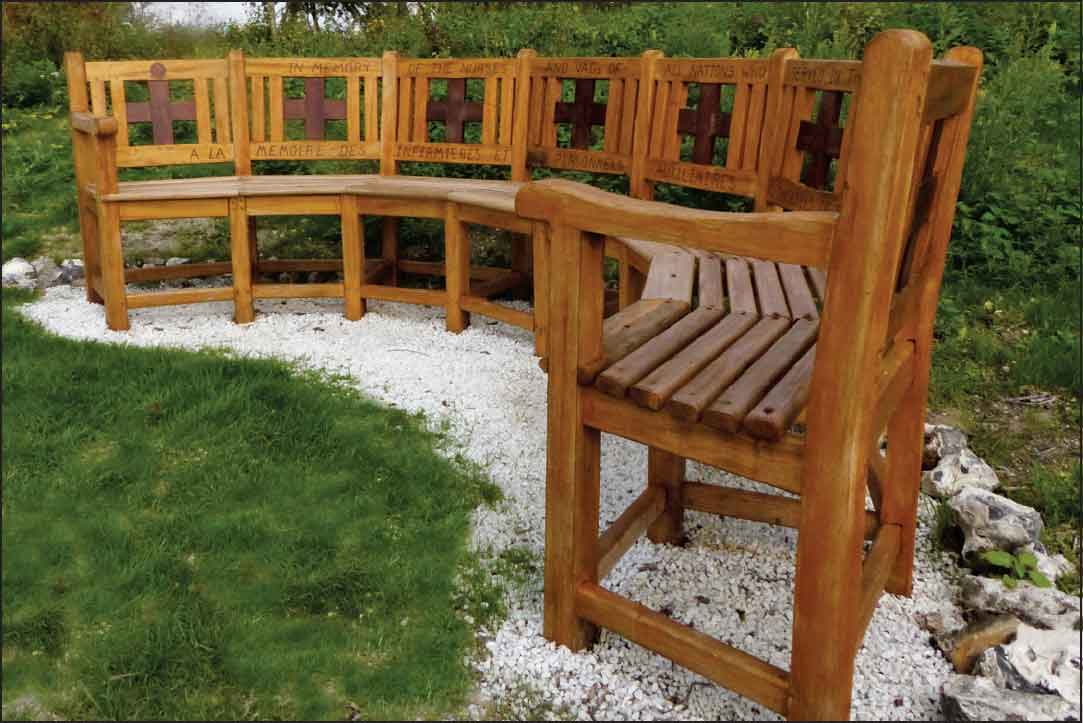ALLIED AND GERMAN WARGRAVES & COMMEMORATIVE ASSOCIATIONS
AMERICAN BATTLE MONUMENTS COMMISSION (ABMC)
The Commission was established by Congress in March 1923 and has been responsible for commemorating members of the American Armed Forces where they have served overseas since 6 April 1917 (the date of the U.S. entry into WW1). Its task was to erect suitable memorials and cemeteries. It now administers 24 permanent burial grounds (in which there are 30,921 WW1 burials in 8 cemeteries of a total of 116,516 killed in the war), 21 separate Monuments and three ‘Markers’, as well as four Memorials in the USA.
Its first chairman was Gen John J. Pershing (qv) who served until his death in 1948 when he was succeeded by another WW1 veteran, Gen George G. Marshall. From 1959 to 1969 the Chairman was Gen Jacob L. Devers and he was followed by Gen Mark Clark until his death in 1984. From 1985 to 1991 Gen Andrew J. Goodpaster served, to be followed by Gen P.X. Kelley, Gen Frederick F. Woerner in 1994 and Gen P.X. Kelley again in 2001, followed by Gen Frederick M. Franks Jr. The current Chairman is Retired Air Force Gen. Merrill A. McPeak, who was chief of staff of the U.S. Air Force from 1990 to 1994. He was elected in June 2010.
After WW1 families were allowed by the War Department for the Dead to choose to have their loved ones repatriated (at Government expense) or to be buried near where they fell. In each of the beautifully landscaped WW1 cemeteries at Brookwood, Surrey; Flanders Field, Waregem; Somme, Bony; Aisne-Marne, Belleau; Oise-Aisne, Fère-en-Tardenois; Meuse-Argonne, Romagne; St Mihiel, Thiaucourt and Suresnes, near Paris, there is a non-denominational Chapel (although the atmosphere is predominantly Christian). The land for the cemeteries was given free of charge by the various host countries. The graves are surmounted by brilliant white marble crosses, interspersed by Stars of David for Jewish servicemen. There is no appropriate symbol for men and women of other denominations or for atheists and when the authors queried how a Star of David came to be placed on the grave of an Unknown in Flanders Field the Superintendent explained that the percentage of Jewish servicemen was known and the Unknowns were deemed to be Christian or Jewish in that same proportion. Unknown graves bear the legend, ‘Here rests in honored glory an American soldier known but to God.’ Identified graves bear the name, unit, date of death, (but not of birth), and the home State. Headstones of Medal of Honor winners bear a gold star and the wording is picked out in gold. The pristine grave markers are laid out in perfectly symmetrical lines on immaculately manicured emerald green grass. There are no flower beds in front of the rows but the graves areas are surrounded by beautiful shrubs and trees. Each cemetery contains a luxuriously-appointed Visitor’s Room with a Superintendent’s office where information about the burials may be obtained and in which there is always a Visitor’s Book, an example of the Purple Heart medal and photographs of the current President of the USA and of other American cemeteries. Most cemeteries contain Tablets of the Missing and features like marble battle maps, colourful mosaics and dramatic sculptures. Some of the best architects of the day were employed to design them.
The American flag flies proudly and is lowered when the cemetery closes (now a standard 1700 hours in each cemetery throughout the year, opening time 0900) when Taps (the American equivalent of the Last Post) is played. There are rest rooms and good parking. The overall impression is one of pride and glory, with gilded seals and mosaics much in evidence giving the feeling that no expense should be spared to honour the dead.
A progressive programme of installing carillons with pealing bells and a sequence of patriotic and wartime songs in ABMC Cemeteries is underway and is funded by the McCormick (qv) Tribune Foundation (www.rrmtf.org who donate the necessary funding to AmVets National Service Foundation www.amvets.org). The first carillon was installed in 1985 in the Manila Cemetery and the process in still continuing. Of the WW1 Cemeteries the Aisne-Oise, Meuse-Argonne, Oise-Aisne and Somme (Bony) already have their carillons.
As well as the Cemeteries, the ABMC maintain the impressive WW1 Memorials at Audenarde, Kemmel, Bellicourt, Cha[with circumflex]teau-Thierry, Cantigny, Sommepy, Montfaucon, Montsec and Brest (Naval).
There are also some 700 Private American Memorials in Europe which are presently being located and listed, often by the Superintendents in the nearest ABMC Cemetery. Many of them are in a neglected state but local authorities are being encouraged to help maintain them and there is now a non-profit-making charitable organisation, American War Memorials Overseas Inc, whose mission is to document, raise awareness of and care for these private memorials. Contact: Lil Pfluke (a long-time friend of the authors) 6 rue de Larienty 92210, St Cloud, France. Tel: 336 1173 1332. E-Mail: info@uswarmemorials.org website: uswarmemorials.org
Memorial Day programmes are held on different days near to the actual Memorial Day date at the end of May in each ABMC Cemetery. Then every grave is decorated with the flag of the United States and that of the host nation. There are speeches, usually including one from the appropriate American Ambassador, and the laying of wreaths with ceremonies that include military bands and units.
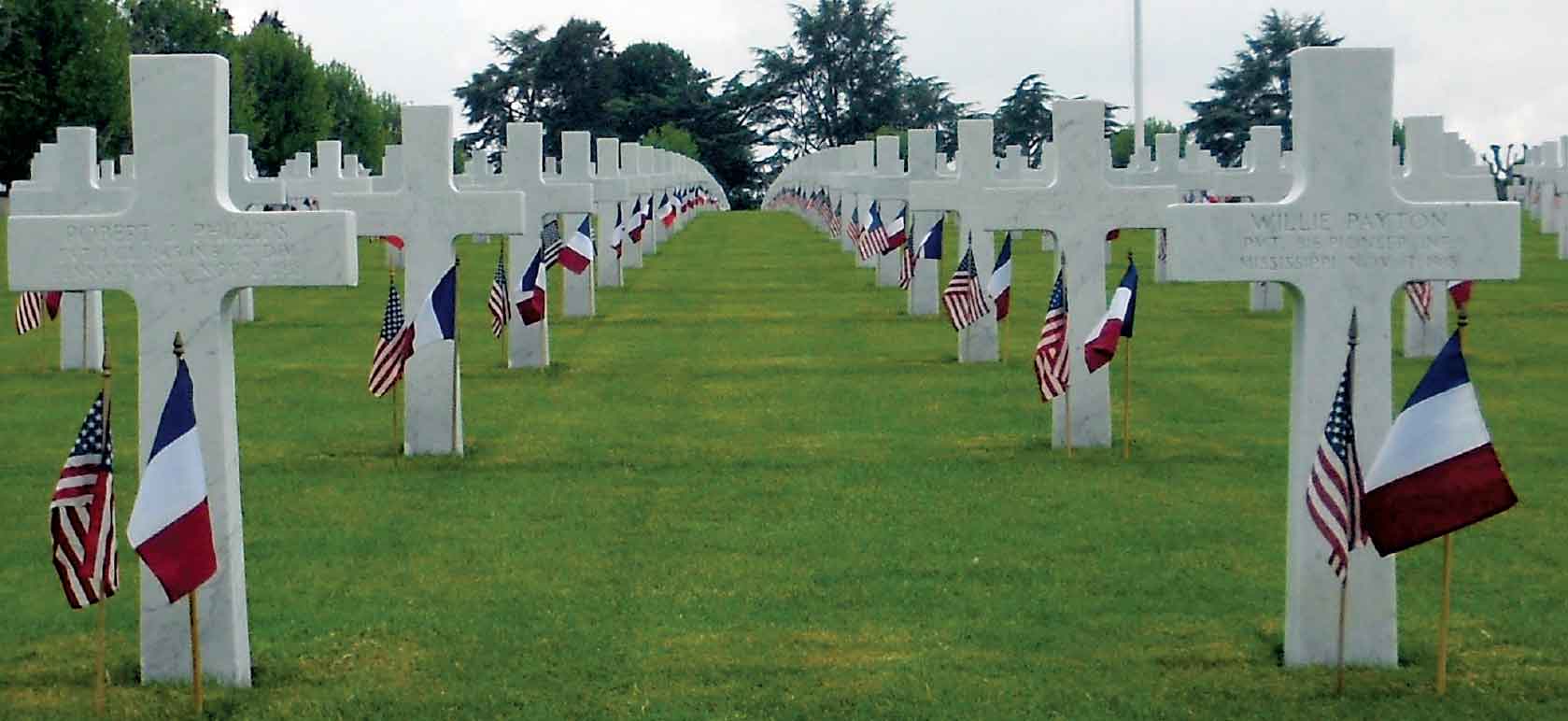
Memorial Day 2015, Somme American Cemetery, Bony
The nearest American Cemetery to the Somme is at Bony in which there are 1,844 named burials and 333 ‘mia’. Tel: +(0)3 23 66 87 20. E-mail: somme.cemetery@abmc-er.org. Open: 0900-1700.
Head Office: Courthouse Plaza II, Suite 500, 2300 Clarendon Boulevard, Arlington, VA22201, USA. Tel: + 703 696 6897. Fax: + 703 696 6666. Website: www.abmc.gov.
European Office: 68 rue du 19 janvier, 92380 Garches, France. Tel: + (0)1 47 01 19 76.
COMMONWEALTH WAR GRAVES COMMISSION
Summary Of The Commission’s Work By Mr Colin Kerr, Director External Relations, With Particular Reference To The Somme Centenary
Part of the landscape of any of your tours will be the Commission’s war cemeteries. Large or small, on open plains, or on high peaks, these cemeteries provide a form of reassurance that these men are not forgotten and that, by maintaining sites in a condition of quiet beauty, we somehow see our own values reflected back on us. The sheer scale of a Tyne Cot or a Bayeux can be, literally, shocking to the first time visitor, but any quick scan through the visitors’ books will tell you that these sites still retain the power to move people.
Origins
Traditionally, the Commission has kept a very low profile (although this is changing); so, who or what is this organisation, recently described by Sir Max Hastings as a “national treasure”?
Prior to 1914, the military practice after a battle was to place all of the dead into a large pit. This was still the practice in 1914. However, a young officer in the Ambulance Corps, Fabian Ware, working in France in 1914, began to establish a more formal “graves registration unit” and, with Government support, a comprehensive process of recording and tracking was put in place, which continued until the end of the war. By 1917, the scale of the losses was such that an Imperial War Graves Commission was established by Royal Charter, with the Prince of Wales as the patron, managed by Ware.
In the aftermath of the war, cemeteries were constructed on land donated “in perpetuity” to Britain, with a “cross of sacrifice” and a “stone of remembrance” In some cases, bodies were exhumed and brought into more central locations. Headstones (of Portland stone) replaced the wooden crosses and families were given the option of adding personal lines at the bottom of each headstone. Major figures worked with the Commission, including Lutyens and Kipling. After impassioned national debate, important decisions were taken: there would be no repatriation of bodies and there would be no distinctions of rank: a general’s headstone would be identical to a private’s headstone. Of the 1 million dead of the Empire, some two thirds were identified, but the balance were not. Of that remaining one third, memorials would be erected, showing the names of the missing: these would include the massive memorials at Ypres (the Menin Gate), the Somme (Thiepval) and Arras, all designed by Lutyens. Of these men, the bodies of many were found, but could not be identified: they too were buried and Kipling created the phrase “a soldier of the Great War, known unto God”. When the Menin Gate was opened by General Plumer in 1926, he declared that “they are not missing, they are here”. The words were Kipling’s. Churchill, in a speech to Parliament, talked of “periods as remote from our own as we ourselves are from the Tudors, when the graveyards in France shall remain an abiding and supreme memorial to the sacrifices made in the great cause”.
This had been a world war. Beyond the western front, cemeteries and memorials were erected in Palestine, in Mesopotamia, in Macedonia, in Gallipoli, in Italy and in a host of far flung sites from China, to Kenya, to northern Russia, to the Falkland Islands. The Commission established itself in headquarters in London and was funded by the main countries of the Empire, proportionate to the losses (which were 80% British). The Commission hired skilled gardeners to bring a sense of tranquillity to the sites and skilled craftsmen to maintain the walls and the headstones. A couple of myths to dispel: the gardens were not designed by Gertrude Jeykll (although she participated in some initial thinking) and they were not supposed to be an “English country garden”. The design guidance, drafted by Frederick Kenyon in 1918, talked only of ‚Äúa sheet of grass and occasional beds of flowers‚Äù.
Naval casualties were a different matter. Although a specifically naval cemetery was built at Scapa Flow, in the Orkneys, most men went down with their ships. Accordingly, three huge memorials were constructed at Portsmouth, Plymouth and Chatham, to record the names of the missing, most of which were lost at the Battle of Jutland. A further memorial was built at Tower Hill, in London, for the Merchant Navy seamen lost during the war (including the huge losses from the Lusitania).
In the UK, the situation was also different. Some 250,000 men from World War 1 are buried in the UK, mostly as a result of dying in hospitals, from their wounds (but also from the influenza epidemic). They will be found, mostly, in big city cemeteries, where the local Councils allocated space for the war dead to be buried. Go to any British town today, and you will see, in the main cemeteries, a section with a cross of sacrifice and the neat rows of headstones, with the high standards of maintenance and gardening which you would find in France. British people are generally unaware of what is on their doorstep.
So, the Commission settled down to complete its cemeteries and memorials and then to maintain them as millions of families made their pilgrimages to these resting places.
World War 2
The end of World War 2 brought a further aspect to the work of the Commission, with a further 700,000 casualties of that conflict. Some of the geography was similar (which is why you will find men from both wars in the cemeteries in France and Belgium), but new cemeteries had to be built in the Netherlands, in Germany, North Africa, Italy, Norway, Singapore and Burma. The other significant change was that the major losses of aircrew resulted in scattered graves literally all over the world and to a new memorial to missing aircrew at Runnymede, in England. The existing naval memorials in England were extended to record the names of the missing from this war.
In the 1960s, the Commission changed its name to the Commonwealth War Graves Commission.
The Commission today
100 years on, the Commission continues to go from strength to strength.
With Headquarters now in Maidenhead, England, the Commission comprises the Governments of the UK, Australia, Canada, India, New Zealand and South Africa. It runs its operations from offices in Leamington Spa (UK), Arras (France), Ypres (Northern Europe), Larnaca (Mediterranean) and Delhi (Africa, Asia, Pacific) with smaller offices in Rome, Malta, Cairo, Tel Aviv, Salonica and Gallipoli.
Every year, another 20 to 30 men are found, identified (frequently) and buried with full military honours.
The Arras office contains a headstone production unit, where 22,000 new headstones each year are shipped from the quarries (no longer Portland, but Italy and Bulgaria) and engraved on five machines using computerised images which link back to databases in England. Headstones - particularly in coastal areas - can deteriorate badly over the years. Every five years, the Commission grades every one of its headstones to ensure that, above all else, they are readable.
Details of all 1.7million casualties are stored on the Commission’s database, which is accessible through the website (cwgc.org), where as long as you know the name, they will tell you where he is buried (or his name commemorated) and how to get there. They also keep records of foreign nationals (mainly German and French) who are buried in the Commission’s cemeteries.
If you were to ask the Commission’s staff for a view, they would ask you to think about three things:
* please don’t forget the sites in the UK: just go to your local cemetery
* visitors will always go to the Menin Gate and to Thiepval, but please go a bit off the beaten track and visit the lesser known sites: they are every bit as beautiful and they all have their own stories to tell
* if you are going on holiday, see if there is a site near your destination: they are all over the world.
The Somme 1916 Battles
The Centenary of the Battle of the Somme brings some challenges for the CWGC. The sheer scale of the battle, compounded by the scale of the losses and by the challenges inherent in attempting to make any sort of objective conclusion on the campaign – all of these factors combine to provide unique challenges to CWGC.
Firstly, the scale. The battlefield is some 25 miles square and the Commission has more than 200 cemeteries. Most British people think of the Somme in terms of the overwhelming casualties of July 1 1916: however, the campaign went on for 141 days of very tough fighting. The first challenge for the Commission is in getting visitors to move beyond the iconic sites of July 1 – the Thiepval Memorial, the Ulster Tower, the Caribou at Beaumont Hamel and the Sheffield Park. Vast and beautiful cemeteries lie all over the Somme battlefield, but are far less visited than the July 1 sites. We hope that this excellent guidebook will attract visitors to Flers, Mametz, Lesboeufs, Longueval and a host of other very special locations.
Secondly, the emotional mindset. A visit to any CWGC site, large or small, is – for most people – a deeply moving experience. However, there are nuances. Visitors to the sites in Normandy, for example, cannot help but be moved by the fact that this was a success: without in any way diminishing the sense of loss. Somehow, there is less inclination to think in terms of lives wasted. The Somme, on the other hand, carries a profound sense of waste, almost as an inherent part of the national psyche. It is not for the Commission to argue the rights and wrongs of the Somme campaign, but any appraisal of the Somme must recognise that it stopped the German assault on Verdun and that it had a huge impact on the German Army (whose losses matched the British).
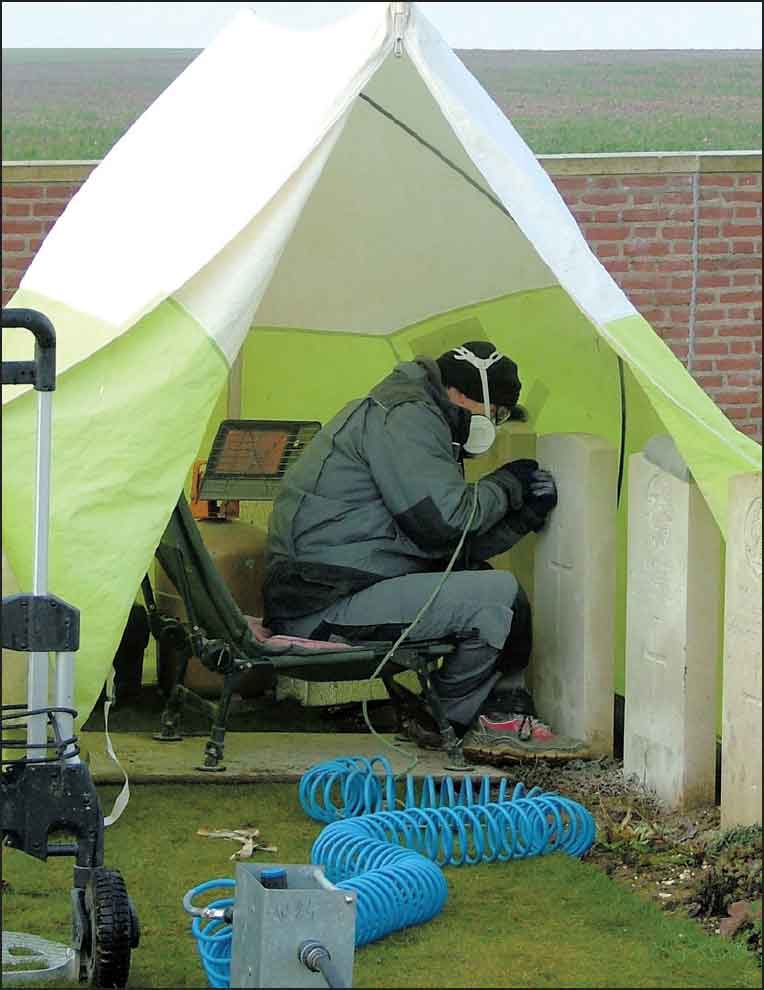
Engraving headstones in the field
Thirdly, the Commonwealth countries. British people think of the Somme in terms of July 1, although the British elements of 4th Army were in action for some ten weeks. However, for the Commonwealth forces, their key dates are not July 1 (other than the Newfoundlanders), but are those dates on which their forces came into the line over the 141 days. So, for South Africans at Delville Wood, Canadians at Courcelette, Australians at Pozieres or New Zealanders at Longueval, the locations are different and the dates are different. The same point applies to the Welsh at Mametz.
Fourthly, on behalf of the MoD, the Commission maintains scores of Battle Exploit Memorials (BEMs) – some small, some very large – right across the Somme battlefield. For many people, these memorials will be the focus of their visit. The details are set out in the guidebook, but the Commission encourages visitors to the memorials to be sure and visit the nearby cemeteries.
Maintenance of the sites on the Somme is a major commitment for CWGC. We maintain the Thiepval Memorial and we appreciate deeply that large numbers of people still come to this profoundly special place. But we would also encourage visitors to go further in to the battlefield: use this excellent guide and visit the beautiful CWGC sites across the whole of the Somme – these men must not be overlooked.
Colin Kerr
Director External Affairs
Note: If you are visiting the Somme with the aim of finding a specific grave or memorial it is important to check the location before you leave. Contact: Head Office, 2 Marlow Road, Maidenhead, Berks, SL6 7DX, UK. Tel: +(0)1628 507200. Website: www.cwg.org (which includes the Debt of Honour Register). E-mail for enquiries: casualty.enq@cwgc.org.
The Area Office in France is at rue Angèle Richard, 62217 Beaurains (see Itinerary One), Tel: +(0)3 21 21 77 00 E-mail: france.area@cwgc.org.
There is an interesting and informative CWGC Newsletter: newsletter@cwgc.org that will also keep you up-to-date.
19-18 Project Manager: Andrew Stillman: E-mail: andrew.stillman@cwgc.org
Also be aware that there will be many commemorations for the Centenary of the Somme 1918 battles (See Itineraries 5 and 6).
JOINT CASUALTY & COMPASSIONATE CENTRE (JC&CC)
In April 2005 the Army, Navy and RAF amalgamated in the Joint Casualty & Compassionate Centre, part of the Service Personnel and Veterans’ Agency, to deal with any remains of service personnel (principally from WW1 and WW2) where there was any likelihood of an identification. The agency replaced the MOD PS4(A)NWG Cas/Compassionate Cell. They liaise with local embassies and CWGC and use case files and other appropriate means in their research. Once an identification has been made they use the media to trace any family. The wishes of the family are then paramount as to the form of the burial (e.g. quiet or formal).
Contact: Sue Raftree, RAF Innsworth, GL3 1HW. Tel: +(0)1452 712 612 ext 6303. E-mail: dbs-jcccgroupmailbox@mod.uk Any news will be reported on the general MOD website.
One of the most famous and well-documented find was at St-Laurent-Blangy near Arras, when in January 2001, excavations began for a business site called Actiparc over the sector where, in 1917, five different British units were facing the Germans during the April offensive. Then human remains were discovered, notably a trench containing twenty-three soldiers, with badges of the Lincolnshire Regiment (the Grimsby Chums). Poignantly their arms appeared to be linked together. The CWGC at Beaurains were informed and working with the Arras Archaeological Service and a forensic scientist from MOD PS4 stringent efforts were made to further identify the men. Unfortunately, no identifications could be made and the soldiers were buried in nearby Point du Jour CWGC Cemetery in June 2002. (This cemetery still has space, as the French remains originally buried here in a significant plot were later removed.) A video for television was made of the incident called Bodyhunt Search for the Unknown Soldier.

Iris Empress of India

Iris Pink Horizon
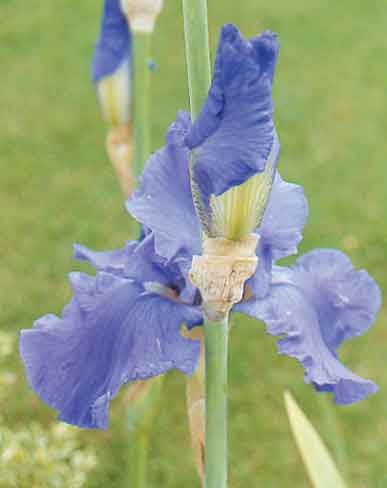
Blue Iris
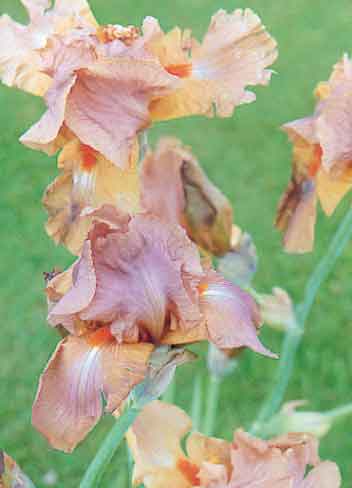
Iris Flamenco

Yellow Rose

Paeony Karl Rosenfield
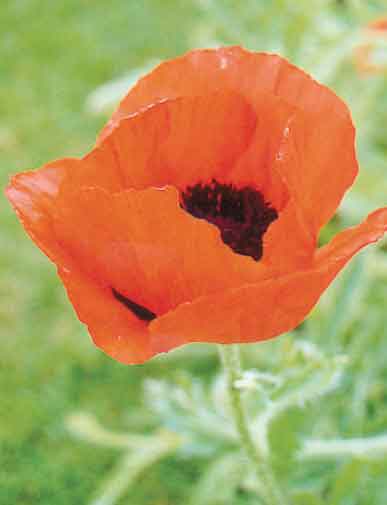
Oriental Poppy

Cerianthus Suber
Selection of flowers in one of some 140 CWC Cemeteries (Adelaide) on the Somme one day (21 May) out of 365.
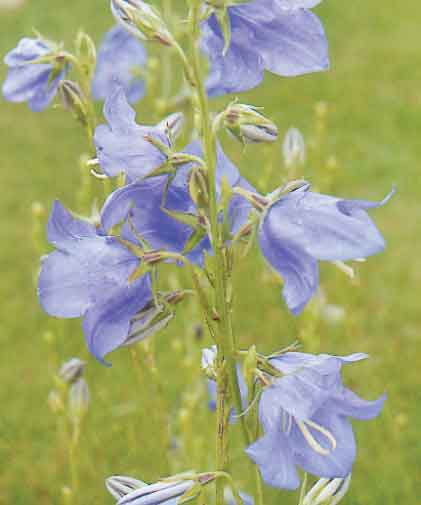
Campanula Telham Beauty

Campanula Persicifolia
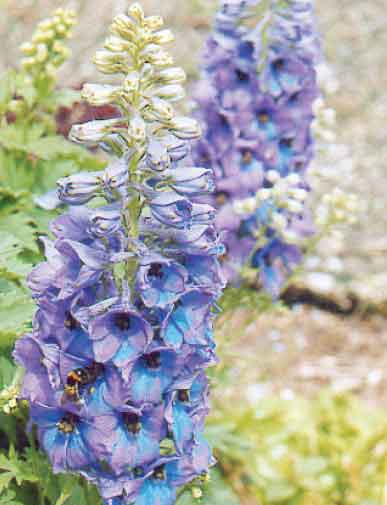
Delphinium Black Knight

Delphinium Summer Skies

Dianthus

Polygonum Bi Sorta
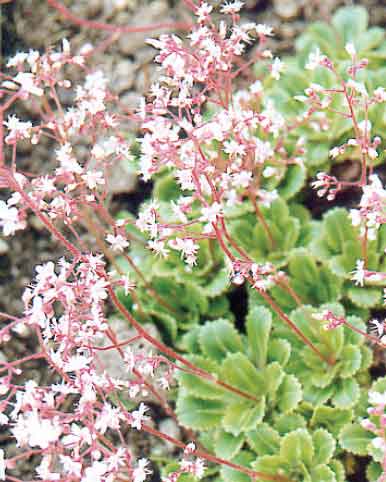
London Pride
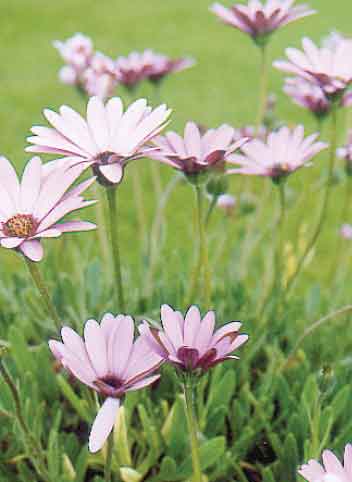
Osteospinum
In the case of remains found at Athie, near Arras, in June 2001 all five sets had 15th Bn Royal Scots insignia found with them. Two sets of remains also had identity discs and one set had a ring with the initials WG inscribed. The CWGC area office, by looking at its own ‘Debt of Honour Register’, was able to ascertain that the two identity discs belonged to soldiers who were still recorded as missing - Cpl William Gunn and Pte Archibald McMillan who were apparently both killed in action on 9 April, the first day of the Battle of Arras. It was also able to supply a list of missing soldiers from 15th Bn Royal Scots whose initials were WG. Research by MOD PS4 traced the family of Pte McMillan and on 20 June 2002 his 87-year-old son, Archie McMillan, his grand-daughter and great-grandson attended the re-interment in Point-du-Jour CWGC Cemetery. The Regiment buried their sons with full military honours on a grey and wet morning with a ceremony of tremendous dignity and tenderness. The authors were privileged to be present.
On 23 April 2013 four soldiers were reburied at Ecoust-St. Mein CWGC whose story can be read on page 282 and the account of the making of a new CWGC Cemetery at Fromelles in 2011, the first to be built for over half a century, is in our Western Front-North book.
SERVICE DES SÉPULTURES DE GUERRE
The French organisation for the maintenance of wargraves and memorials comes under the Ministry of Anciens Combattants et Victimes de Guerre. Details of the Nécropoles Nationales can be obtained from their head office at 37 rue de Bellechasse, 75007 Paris. Tel: +(0)1 48 76 11 35.
A law was passed on 29 December 1915 to give the rights to a free, and eternally maintained grave to every French or Allied soldier who was killed in the war. Another law was passed on 18 February 1916 to set up a service to deal with pensions, to give information to families and to cope with the thousands of burials of the enormous casualties that were being incurred. On 25 November 1918 a National Commission of Military Graves was set up which undertook to progressively make landscaped cemeteries, each with a flagpole (and it is marvellous to see the French tricolore proudly flying), and to mark each grave with a concrete cross or headstone (for Colonial forces, agnostics, Jewish burials etc). The marker bears the soldier’s rank, name, regiment and date of death and the words, ‘Mort Pour la France’. As with the CWGC, there are differently shaped markers for each nationality. The Treaty of Versailles of 28 June 1919 specified that each signatory country should respect and maintain the graves of military foreigners on their land. On 27 January 1920 the Ministry of Pensions absorbed the Service des Sépultures and regional teams were set up. The immediate post-war task of identifying bodies and helping relatives to find their loved ones’ burial sites is movingly depicted in Bernard Tavernier’s award-winning 1989 film, La Vie et Rien d’Autre (‘Life and Nothing But’). On 31 July 1920 the cemeteries became ‘national’ and many small front-line cemeteries were concentrated into these larger national burial grounds. By the end of 1925, 960,000 reburials had been made and the bodies of 22,000 Poilus had been repatriated from Germany. Between 1926 and 1935 more than 122,000 French and German bodies were found, without graves, on the battlefields. On 11 July 1931 the treasury voted funds to embellish the cemeteries and the larger ones, like Notre Dame de Lorette (France’s largest military cemetery with 20,058 graves and 20,000 in mass graves, on a 25 hectare site) were quickly completed.

French National Cemetery, Notre-Dame de Lorette, showing Lantern Tower
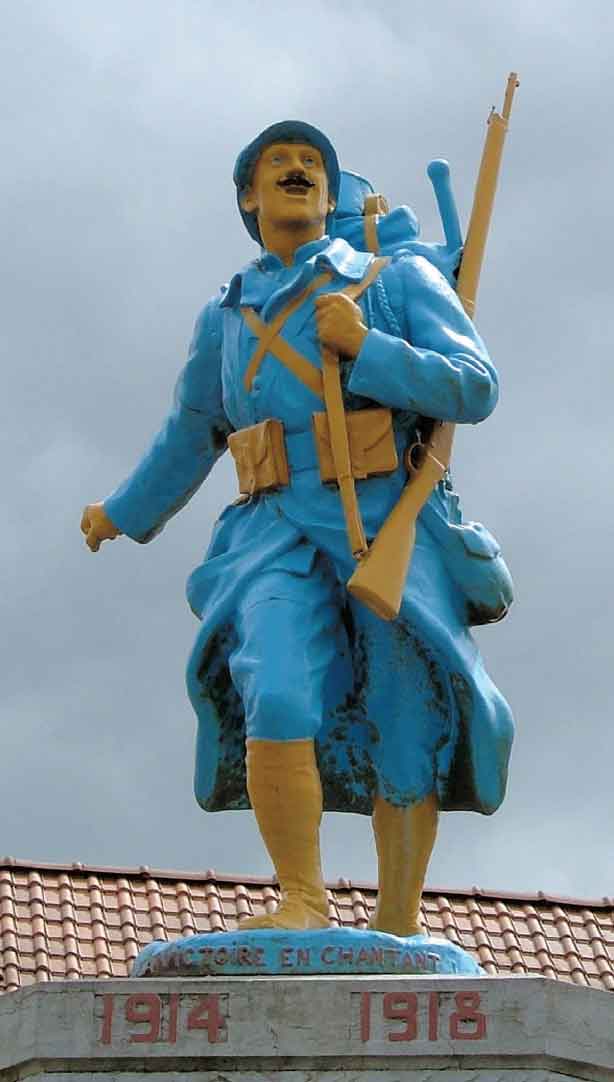
Ayette Poilu Memorial, ‘Singing in Victory’
Like the CWGC, the French decreed that there should be no distinction because of rank or status in the burials, following the Constitution’s principal of equality. No ‘sumptuous’ decoration could be placed on the graves and only cut flowers. Unidentified bodies would be buried in mass graves (ossuaires) which should be surrounded by a wall and bear a memorial plaque. The erection of individual monuments was permitted by families and regiments. At first only ‘sterile’ material, like gravel, was allowed round the lines of graves and on the mass graves. But in 1950 lawns and polyanthus roses were permitted. It is very evident that this concept has been emphasized in the past few years and the somewhat stark appearance of the French cemeteries is now giving way to the more garden-like aspect of the British, with more flowering shrubs and sheltering trees. Maintenance is organized in sectors, with a technical service which has an annual budget. There is a box inside the entrance gate of most cemeteries, with the cemetery register and, a recent addition, a Visitors’ Book. Other recent additions are explanatory boards just within the cemetery gates which describe the historical background of the Somme battles and show the national cemeteries in the area. The Ministère des Anciens Combattants et Victimes de Guerre publish an Atlas des Nécropoles Nationales, which is obtainable from the Historial de la Grande Guerre at Péronne. It describes the 265 national cemeteries in France, and divides them into sectors, each with a map. There are some twenty in the Somme battlefield area.
SOUVENIR FRANÇAIS
This association was founded in 1872, after the Franco-Prussian War and revived after World War I. Its aim is to keep alive the memory of those who died for France, to maintain their graves and memorials in good condition and to transmit the ‘flame of memory’ to future generations. Their Head Office is at 9 rue de Clichy, 75009 Paris. There are active local branches in Albert, Amiens and Arras. Signs of their attentive care can be seen on many of the local ‘Poilu’ memorials, and on private memorials, French and British, in the area. Often their red, white and blue roundel insignia is attached when refurbishment has taken place. Representatives lay wreaths at many ceremonial and commemorative ceremonies.
Somme Branch: Contact Mme Lisette Quéyrat, 19 Rue de L’Eglise, 80131 Framerville-Raincourt. Tel: + (0)3 22 85 82 91.

The Souvenir Français Roundel
VOLKSBUND DEUTSCHE KRIEGSGRÄBERFÜRSORGE (VDK)
In September 1919 Siegfriend Eulen, a former army officer, initiated what was to become the VDK of today. He believed that an organisation should be established to locate, mark and care for German war graves and that it should be a charity. He sought and obtained the support of like-minded people for his idea. Thus the beginnings of the VDK have an interesting parallel with the initiative taken by another individual, Fabian Ware, which was the formation of today’s CWGC.
By the end of the 1919 Eulen’s initiative had led to the creation of a working committee with the name Volksbund Deutsche Kriegsgräberfürsorge – The People’s Association for War Graves – which, now having obtained political support, set out to estimate the size of the task. It took ten years to find out that almost one million German war dead would need to be commemorated in some 30 countries and that around half of those were in France. The ‘five crosses’ symbol used by the VDK is an interpretation of a photograph on the cover of the organisation’s first publication of German graves in Poland. It appears on the ironwork gates of many cemeteries and the signs which directs one to the cemetery.
The VDK organises the Volkstrauertag – Memorial Day (a day of national mourning) – each November, which takes place locally and also centrally in the Bundestag.
The German War Graves Welfare Association’s Head Office is at Werner-Hilperts Strasse 2, D-34117 Kassel, Germany. Website: www.volksbund.de The organisation is similar in function to the Commonwealth War Graves Commission in that it maintains the war cemeteries and memorials to the German War Dead from World War I onwards, and assists relatives in locating and, in many cases, visiting the graves.
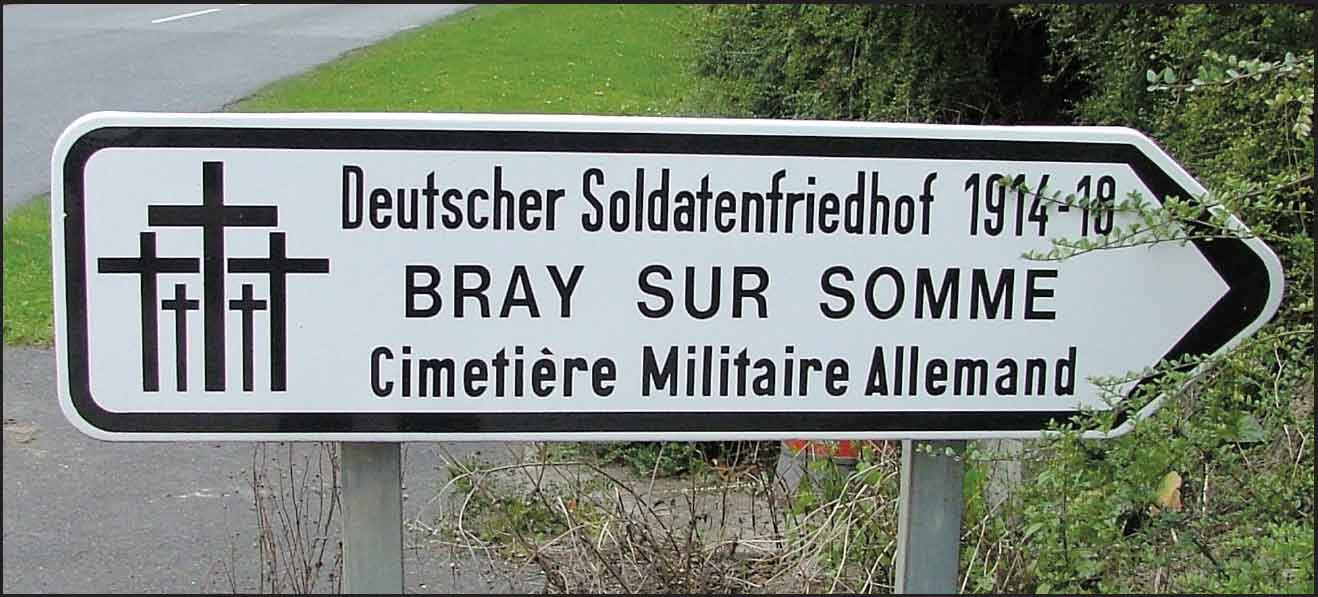
Sign to German Cemetery, Bray
The German cemeteries are not as standardly uniform as the British and French. The markers vary from flat tablets, to upstanding squat stone crosses, to black metallic crosses. Jewish soldiers are marked with a headstone, which bears the Star of David. The markers bear scant information, sometimes only a name, with occasionally a rank, regiment and date of death. Most cemeteries have a mass grave, the names of the unidentified missing soldiers probably buried therein being listed on bronze panels. Under the majority of markers two, four or even more soldiers will be buried. There are two reasons for this. It signifies ‘comradeship in death’ and also, on a practical note, the Germans were not allocated as much territory in which to bury their dead as were the Allies. In some German cemeteries there is a small memorial chapel, and often there will be some statuary – normally of bereaved parents or comrades. There will be a register in alphabetical order and sometimes a Visitors’ Book to sign. Oak trees, symbolizing strength, are a frequent feature. There is a marked lack of flowers and colour in most German burial grounds. They are sad, sombre, mournful places – but then the death of a soldier is sad and mournful.
The maintenance of the German cemeteries in France is administered by the Service for the Care of German Cemeteries (SESMA), whose regional office is at rue de Nesle prolongée, 80320 Chaulnes, Tel: +(0)3 22 85 47 57. There are thirteen German cemeteries on the Somme Battlefield of 1916-18 including (number of burials in brackets): Sapignies (1,550); Achiet-le-Petit (1,314); Villers-au-Flos (2,491); Fricourt (17,026); Rancourt (11,422); Bray (1,122); Proyart (4,634); Morisel (2,642) and Vermandovillers (22,600). Individual leaflets are available for each of them, but all German War Cemeteries in France, Belgium, Luxembourg and Holland are described, with maps, in the Atlas Deutscher Kriegsgräber, available from the Head Office in Kassel.
There is also a WW2 Cemetery at Bourdon (off the A16 near Exit 21 near Amiens) containing 22,213 burials. Here on 21 September 2007 the remains of Lt Hans-Joachim Rimarski were re-interred. They had been found in the wreck of his Messerschmitt 109-4 by the Somme Aviation ‘39-’45 Association. The simple ceremony was attended by the authors in the presence of the German Defence Attaché from Paris but sadly, despite the identification and attempt to find them, no relatives. The small casket was buried to the left of the headstone bearing 21 year old Rimarski’s name. The next burial will be central to the headstone, the third to the right and the two other names inscribed below Rimarski’s. The young pilot of the 2nd ‘Richthofen’ Squadron was brought down by an American B-26 on 19 August 1943.
CONSEIL GENERAL DE LA SOMME/HISTORIAL/CIRCUIT DE SOUVENIR
The Département de la Somme is working with the Historial Museum at Péronne to preserve and promote battlefield sites in their area. Notable are the acquired sites of the preserved trenches at Soyécourt (Map 1/31), the Gibraltar bunker at Pozières (Map G48) and the site of the vanished village of Fay (Map 1/27a). Routes for a Circuit du Souvenir are marked by a stylised red poppy on a brown sign and there is a booklet and leaflet describing it. Descriptive signboards are progressively being placed at the entrance to sites of historic interest (signified by CGS/H - Conseil Général de la Somme/Historial throughout this book). They are at: Australian Memorial, Villers-Bretonneux; Australian Memorial, Mont St Quentin; Newfoundland Memorial, Beaumont-Hamel; New Zealand Memorial at Longueval; South African Memorial, Delville Wood; Ulster Tower; Thiepval Memorial; Lochnagar Crater, la Boisselle; Canadian intervention at crossroads of D23 Villers-Bretonneux-Moreuil; P’tit Train, Froissy; Lochnagar Crater; Souvenir Français Chapel, Rancourt; Tank Memorial, Pozières; Bazentin; Frise; Combles; Mametz (to the Welsh Memorial); Maricourt; Maurepas; Sailly-Laurette and four signboards that relate to Manfred von Richthofen, the ‘Red Baron’ – at Cappy, Vaux-sur-Somme (near the brickworks), Bertangles and Fricourt. Website: www.somme14-18.com. It must be pointed out, however, that many signboards are in very agricultural areas and prone to destruction by passing tractors!
ASSOCIATION PAYSAGES ET SITES DE MEMOIRE DE LA GRANDE GUERRE.
Founded in Paris in 2011 to undertake the enormous task of preparing an inventory and plan for UNESCO recognition of WW1 memorial sites on the Western Front. This involves 12 French Departments from Nord-Pas de Calais to the Haut Rhin, plus sites in Belgian Flanders and Wallonia, with a total of 45 major sites. A significant number of them are on the Somme battlefield. In 2015 the Association declared its aims to avoid the ‘touristic Disneyfication’ of the battlefield sites and to promote their moral value for humanity with the obligation of keeping alive the memory and the desire to learn.
The authors are proud to be ‘Partenaires’ and totally support this aim.
Contact: Secretaire-général Serge Barcellini, Controleur Général des Armées. E-mail: paysagesetsitesdememoire@gmail.com Website: FIRST WEBSITE CHANGED - www.heritage-grandeguerre.fr www.paysages-et-sites-de-memoire.fr
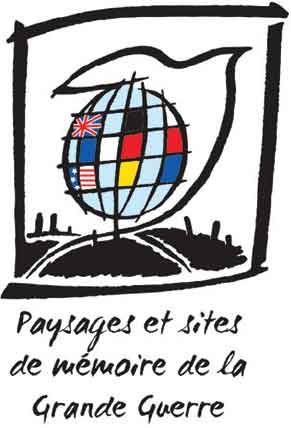
THE DURAND GROUP
For Historical Research Into Subterranean Military Features
This ‘fraternal association of individuals who have voluntarily undertaken to work together’ comprises former and current military personnel and civilians with skills as historians, archaeologists, technicians, explosives and munitions experts, engineers, archivists, surveyors, cartographers, mountain and cave rescuers, IT, film production and medics. In just a few years they have become a pre-eminent authority on what might be described as ‘underground battlefields’ using highly sophisticated and technological equipment and methods in a most responsible manner.
The work that triggered the later formation of the group was initially organised by Lt Colonel Phillip Robinson in the late 1980s at the behest of the Director of the Vimy Memorial Site. The Royal Engineers investigated the La Folie mining system, and found two armed mines, one of which, the Durand Mine (the abandoned fougasse mine which gave the group its name), contained 6,000 lb of ammonal and was located under a public area. Research also suggested a much larger charge at the end of a blocked tunnel close to the Broadmarsh crater.
In 1996, upon return from extended service abroad, Phillip Robinson organised a volunteer team to access the Broadmarsh mine. Fortuitously, it was thought to have been neutralised but further investigation of the Durand mine by Lt Col Mike Watkins, a serving officer of the Royal Logistic Corps and a leading EOD expert, indicated that it was fully viable and a potential threat. Working in arduous and dangerous conditions Mike Watkins disarmed it.
Following from this Mike Watkins and Phillip Robinson formed and constituted the Durand Group. Working in co-operation with Veterans Affairs Canada, the Group has since accessed about seven kilometres of tunnels under Vimy Ridge, disarmed two further sitting mine charges and undertaken archival and site studies aimed at identifying areas of potential risk to the public and site staff. In addition to two of the deep British fighting systems and a German system – which is still being investigated – they have also opened up nearly 500 metres of the former Goodman subway, revealing extensive and sometimes poignant graffiti inscribed by the Canadian soldiers as they waited to move into their assault positions.
Other work has included advice on underground features during construction of the Thiepval Visitor Centre (qv), assistance to the Pas de Calais and Arras archaeological authorities, continuing investigation of underground workings at Beaumont Hamel and recording and correlation of graffiti.
A professionally produced film of the early work of the Group is available through www.fougassefilms.co.uk in the form of a DVD, complete with multi-media resource pack. This vividly portrays the work of the Group, and the particular hazards, highlighted by the tragic dedath of Lt-Col Mike Watkins in 1998 when part of an excavation at Vimy collapsed upon him. He is commemorated on a Memorial Plaque placed by Veterans Affairs Canada near the entrance to the Grange subway at Vimy.
During projects the Group is usually based at a former farm near St Pol owned by one of the Members. They can be contacted through their website, www.durandgroup.org.uk which gives much information on their work. Reports and DVDs covering certain projects are also available. Additionally a charity has been established (with Lord Astor of Hever, grandson of Field Marshal Earl Haig, as Patron) to support research and investigation into military mining and promote knowledge of the Tunnellers. Donations to the ‘Durand Charity (No. 1105311), which may be gift aided, are welcome.
THE FRIENDS OF LOCHNAGAR
Founded on 1 July 1978 this Association aims to preserve the Lochnagar Crater and the memory of the men who fell there in 1916. Contact: Founder and Chairman, Crater owner Richard Dunning, Little Down, Hog’s Back, Seale, Surrey, GU10 1HD. E-mail: Richard.dunning@uwclub.net.
Nurses & VADs Memorial Seat, Lochnagar
Excellent magazine, The New Chequers, e-mail: chequers@friendsoflochnagar.co.uk Website: http://www.lochnagarcrater.org/
THE ROYAL BRITISH LEGION (RBL)
The UK’s foremost Association for the welfare of ex-servicemen, formed in 1921, through the energetic efforts of Earl Haig, received its Charter in 1925 and its ‘Royal’ prefix in 1971. Active Somme Branch. Contact: President Rod Bedford, Tel: +(0)3 22 76 29 60, e-mail: chairman@rblsome.org website: http://www.britishlegion.org.uk/branches/somme
Annual ceremonies at Thiepval on 1 July and 11 November, Annual Dinner 30 June. Newsletter - The Somme Bugle.
THE SOMME ASSOCIATION
Contact their base at the Somme Heritage Centre/Museum at 233 Bangor Road, Newtownards BT23 7PH, Co. Down, N. Ireland, Tel: +(0)28 9182 3202, website: www.Irishsoldier.org E-mail: shc@hotmail.co.uk The Association Director, Carol Walker, daughter of Ulster Tower stalwarts Teddy and Phoebe Colligan, is dedicated to coordinating research into Ireland’s part in the First World War (e.g. of the 10th and 16th (Irish) and 36th (Ulster) Divisions). It has research and education programmes, sponsors publications, organises anniversary commemorations and battlefield tours. Much of their information comes from the records of the Ulster Patriotic Fund (an endowment fund for widows and families provided by well-to-do business men, one of whose projects was the building of the Ulster Tower) which is still under the Official Secrets Act. Their database lists every man who served in an Irish Regiment from 1914-1921 and can be searched by name/regiment/details of next of kin/place of commemoration etc. It also maintains the Ulster Tower and its Visitor Centre (qv).
SOMME REMEMBRANCE ASSOCIATION
Founded in July 2005, the aim of this Anglo-French Association is to preserve the memory of soldiers of WW1 on the Somme in collaboration with like-minded organisations and individuals and to co-ordinate commemorative events (such as the unveiling of Memorial to Pte Cox, VC (qv)). Several new plaques, commemorative benches and memorials are planned in the near future for the Centenary. For membership details see their website: www.somme-remembrance.com
Contact: President, Philippe Drouin, Tel: + (0)3 21 59 85 95. E-mail: philippe.dr@tiscali.fr 1 rue de Bapaume, 62121 Achiet-le-Grand. Treasurer, François Bergez.
GUILD OF BATTLEFIELD GUIDES
Launched on 28 November 2003 the Guild aims to provide a ‘kite-mark’ for Battlefield Guides in the form of a badge which the public can trust and which it will be deemed an honour to wear. Mission Statement: “To analyse, develop and raise the understanding and practice of battlefield guiding.” The Guild is an inclusive organisation, not a regulatory body and aims to engender a ‘Club’ environment with a magazine and educational and social meetings. The popular and well respected founder Patron, Prof Richard Holmes, sadly died in 2011. The authors are Founding Hon Members.
Experienced Guild Guides are supporting STS in the Governments’ Centenary scheme to conduct a teacher and two pupils from every State school to the WW1 battlefields.
Contact: The Secretary, e-mail: secretary@gbg-international.com Website: www.gbginternational.com
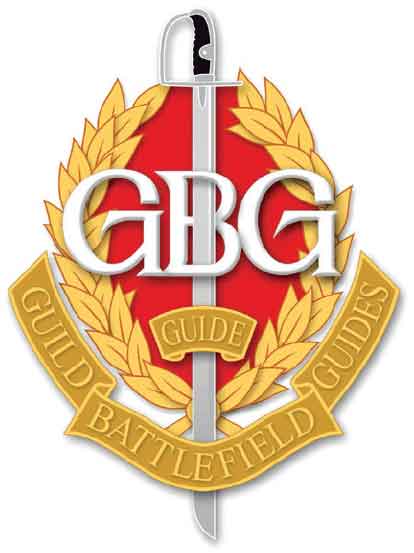
The coveted and respected badge of an accredited Guide of the Guild of Battlefield Guides.
ROSS BASTIAAN BAS RELIEF COMMEMORATIVE PLAQUES
The series of beautifully designed, durable, informative plaques that can be seen at sites on the Somme - at Bullecourt, Digger Memorial; Le Hamel, Town Hall; Mont St Quentin, by the Digger Memorial; Mouquet Farm, by roadside; Péronne, Historial entrance; Pozières, Windmill site and 1st Div Memorial; Vermandovillers Town Hall (non-standard, to McCarthy, VC); Villers Bretonneux Town Hall and at the Australian Memorial – are the inspiration of Australian dentist, Ross Bastiaan (qv). At first Ross received no support (and initially little acknowledgement) from the Government in his dedicated work of designing, researching, creating, erecting and finding sponsors for these magnificent plaques which are gradually being placed around the world wherever Australian forces were engaged with distinction. They were first introduced in Gallipoli in 1990 where the authors first met Ross (recently vandalised and repaired by Ross) and 261 are now sited as far afield as Johannesburg and Damascus. Ross was properly recognised in Australia for his dedicated work and was appointed to be Deputy Chairman of the Council of the Australian War Memorial by then Prime Minister, John Howard, whom he guided round the Gallipoli and Somme battlefields in 2000. His latest project was the erection a Plaque in Portsmouth on the 100th Anniversary of the Monitor ‘M33’ shelling Gallipoli on 6 August 1915. The ship has been restored on the outside but left untouched on the inside, and it is there that one of the most moving battle presentations that the authors have ever experienced has been set up. It is short, with minimum commentary plus a great deal of battle noise, and projected on the surrounding walls of the interior. The nearest other such presentation experienced by the authors is that at Guernica where 90% is in total darkness. Website: www.plaques.satlink.com.au
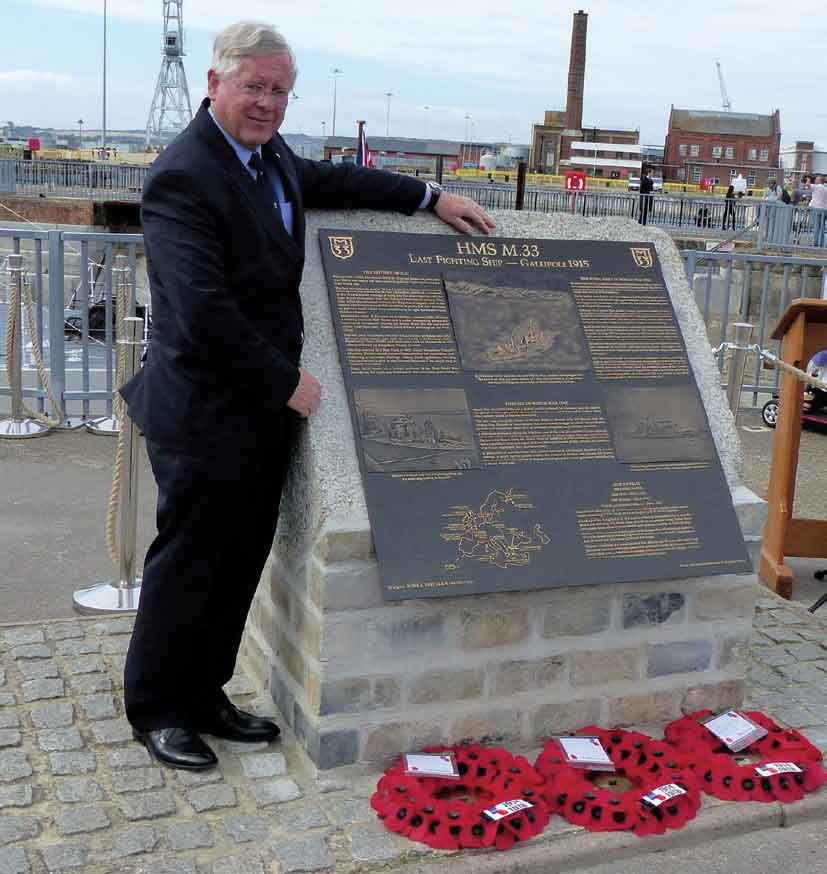
Ross Bastiaan with his Plaque to Monitor M33, Portsmouth
WESTERN FRONT ASSOCIATION (WFA)
Formed by John Giles in 1980 to further the interest in WW1 and to perpetuate the memory, courage and comradeship of all who fought in it. Two excellent publications, Stand To and The Bulletin, Chairman: Bob Paterson. Contact: Hon Sec Stephen Oram, Spindleberry, Marlow Road, Bourne End, Bucks, SL8 5NL. E-mail via the website: www.westernfrontassociation.com
PIPE BANDS
There are two Pipe Bands based in the Somme who attend many commemorative events, inaugurations of new memorials, gatherings of Pipe Bands, Celtic Nations etc, not only on the Somme but throughout France and abroad. They will both be particularly active during the Centenary years.
1. The Somme Battlefield Pipe Band. Founded in 1989 by Ian Alexander (pictured on the front cover), Hon Pipe Major, to promote the music and history of Scottish soldiers who fought in the region, ‘14-’18. Members wear the uniforms of Scottish Regiments who fought on the Somme. www.sommebattlefieldpipeband.com
2. The Samarobriva Pipes and Drums. Founded in Amiens in 2007 by Chairman Pascal Lebeau to unite people who are passionate about Celtic music and culture and to promote remembrance of WW1. Somme Director of Tourism François Bergez (a Breton by birth) is an enthusiastic member. The Conseil Général de la Somme has given the Band a subsidy for the Centennial period. (See page 148).
http://samarobriva-pipes-and-drums.blogspot.com www.unitedpipersforpeace.com/
